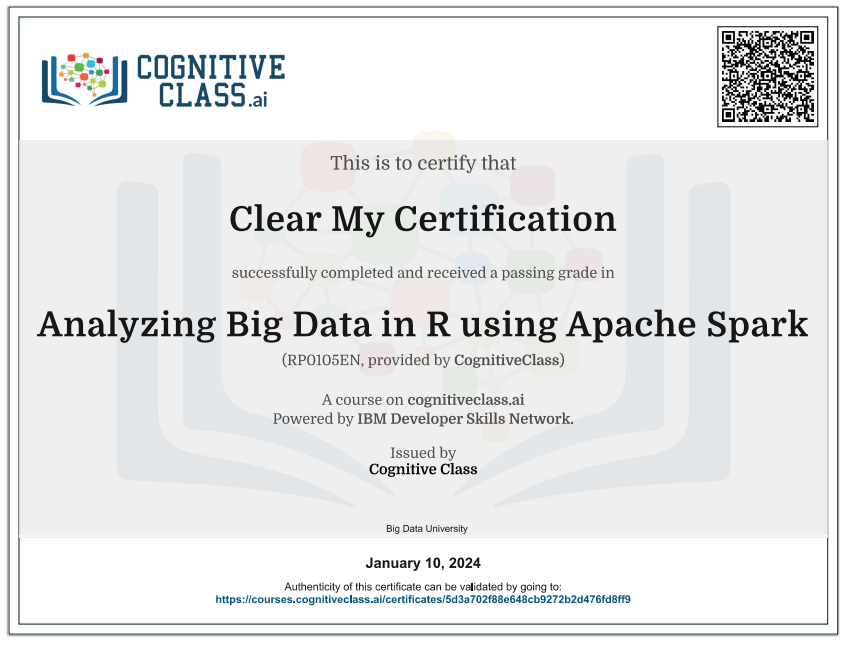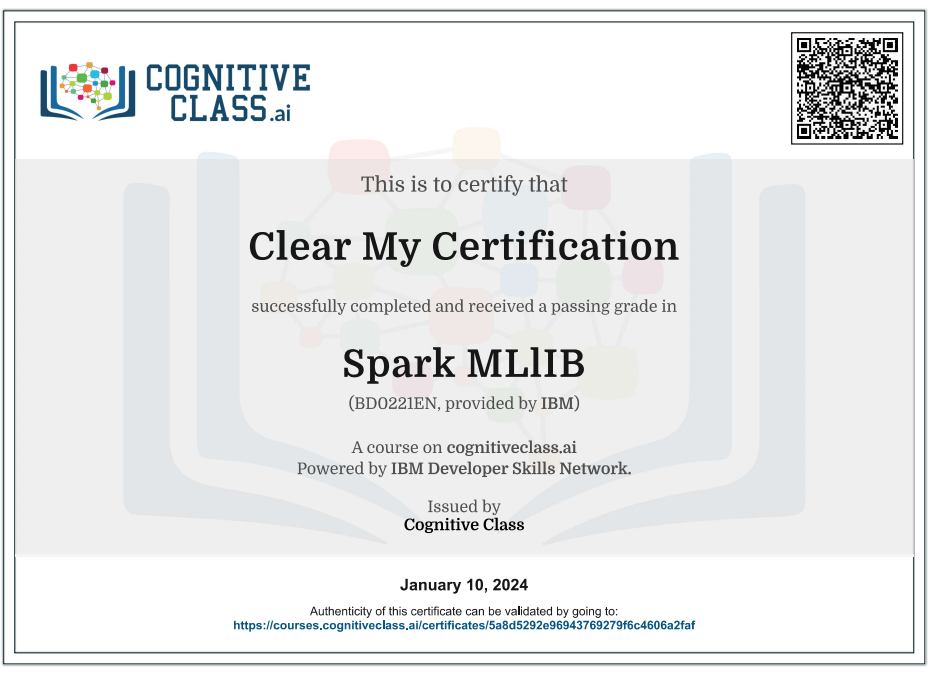Enroll Here: Python for Data Science Cognitive Class Exam Quiz Answers
Python For Data Science Cognitive Class Certification Answers

Module 1 – Python Basics Quiz Answers – Cognitive Class
Question 1: What is the result of the following operation in Python:
3 + 2 * 2
- 10
- 7
- 9
- 12
Question 2: In Python, if you executed name = ‘Lizz’, what would be the output of print(name[0:2])?
- Lizz
- L
- Liz
- Li
Question 3: In Python, if you executed var = ‘01234567’, what would be the result of print(var[::2])?
- 0246
- 1357
- 1234567
- 8903
Question 4: In Python, what is the result of the following operation ‘1’+’2′?
- ‘2’
- ‘3’
- ’12’
- 3
Question 5: Given myvar = ‘hello’, how would you convert myvar into uppercase?
- len(myvar)
- myvar.find(‘hello’)
- myvar.upper()
- myvar.sum()
Module 2 – Python Data Structures Quiz Answers – Cognitive Class
Question 1: What is the syntax used to obtain the first element of the tuple:
A = (‘a’,’b’,’c’)
- A[1]
- A[0]
- A[:]
Question 2: After applying the following method, L.append([‘a’,’b’]), the following list will only be one element longer.
- True
- False
Question 3: How many duplicate elements can you have in a set?
- 1
- 0. You can only have one unique element in a set.
- 100
- Depends on the number of elements in your set.
Question 4: Consider the following Python dictionary:
Dict={“A”:1,”B”:”2″,”C”:[3,3,3],”D”:(4,4,4),’E’:5,’F’:6}
What is the result of the following operation: Dict[“D”]?
- 4
- 3
- [3,3,3]
- (4, 4, 4)
- Error
Question 5: What is an important difference between lists and tuples?
- Lists can’t contain a string.
- Tuples can only have integers.
- Lists and tuples are the same.
- Lists are mutable, tuples are not.
- There are no zeros in lists.
Module 3 – Python Programming Fundamentals Quiz Answers – Cognitive Class
Question 1: What is the output of the following lines of code:
x=1
if(x!=1):
print(‘Hello’)
else:
print(‘Hi’)
print(‘Mike’)
- Hi Mike
- Mike
- Hello Mike
- The Mike
Question 2: What is the output of the following few lines of code?
A = [‘1′,’2′,’3’]
for a in A:
print(2*a)
- 2 4 6
- ‘2’ ‘4’ ‘6’
- ’11’ ’22’ ’33’
- A B C
Question 3: Consider the function Delta, when will the function return a value of 1
def Delta(x):
if x==0:
y=1;
else:
y=0;
return(y)
- When the input is anything but 0.
- When the input is 1.
- Never.
- When the input is 0.
Question 4: What is the correct way to sort the list ‘B’ using a method? The result should not return a new list, just change the list ‘B’.
- B.sort()
- sort(B)
- sorted(B)
- B.sorted()
Question 5: What are the keys of the following dictionary: {‘a’:1,’b’:2}?
- 1,2
- ;,:
- a,b
Module 4 – Working with Data in Python Quiz Answers – Cognitive Class
Question 1: What do the following lines of code do?
with open(“Example1.txt”,”r”) as file1:
FileContent=file1.readlines()
print(FileContent)
- Read the file “Example1.txt”.
- Write to the file “Example1.txt”.
- Append the file “Example1.txt”.
Question 2: What do the following lines of code do?
with open(“Example2.txt”,”w”) as writefile:
writefile.write(“This is line A\n”)
writefile.write(“This is line B\n”)
- Read the file “Example2.txt”.
- Write to the file “Example2.txt”.
- Append the file “Example2.txt”.
Question 3: What do the following lines of code do?
with open(“Example3.txt”,”a”) as file1:
file1.write(“This is line C\n”)
- Read the file “Example3.txt”.
- Write to the file “Example3.txt”.
- Append the file “Example3.txt”.
Question 4: What is the result of applying the following method df.head() to the dataframe “df”?
- Prints the first row of the dataframe.
- Prints the first column of the dataframe.
- Prints the first 5 rows of the dataframe.
- Prints out the entire dataframe.
Module 5 – Working with Numpy Arrays & Simple APIs Quiz Answers – Cognitive Class
Question 1: What is the result of the following lines of code:
a=np.array([0,1,0,1,0])
b=np.array([1,0,1,0,1])
a*b
- 0
- array([1, 1, 1, 1, 1])
- array([0, 0, 0, 0, 0])
Question 2: What is the result of the following lines of code:
a=np.array([0,1])
b=np.array([1,0])
np.dot(a,b)
- 1
- array([1,1])
- 0
- array([0,0])
Question 3: What is the result of the following lines of code:
a=np.array([1,1,1,1,1])
a+10
- array([10,10,10,10,10])
- array([11, 11, 11, 11, 11])
- array([1,1,1,1,1])
Question 4: What is the correct code to perform matrix multiplication on the matrix A and B?
- np.dot(A,B)
- A*B
- AxB
Python For Data Science Final Exam Answers – Cognitive Class
1) What is the result of the following operation 3+2*2?
- 3
- 12
- 9
- 7
2) What is the type of the following variable: True?
- int
- bool
- str
- list
3) What is the result of the following operation int(3.2)?
- 3.2
- 3
- 4
- ‘3.2’
4) Consider the string A=’1234567′, what is the result of the following operation: A[1::2]
- ‘1234567’
- ‘246’
- ‘1357’
- error
5) Consider the string Name=”Michael Jackson” , what is the result of the following operation Name.find(‘el’)
- 5
- 4
- 5,6
- -1
6) The variables A=’1′ and B=’2′ ,what is the result of the operation A+B?
you cant add two strings
- 3
- ‘3’
- ’12’
7) Consider the variable F=”You are wrong”, Convert the values in the variable F to uppercase?
- F.up()
- F.upper
- F.upper()
8) Consider the tuple tuple1=(“A”,”B”,”C” ), what is the result of the following operation tuple1[-1]?
- “A”
- “B”
- “C”
9)Consider the tuple A=((11,12),[21,22]), that contains a tuple and list. What is the result of the following operation A[1]:
- ((11,12),[21,22])
- (11,12)
- (21,22)
- [21,22]
10) Consider the tuple A=((11,12),[21,22]), that contains a tuple and list. What is the result of the following operation A[0][1]:
- 12
- 11
- 22
- 21
11) What is the result of the following operation ‘1,2,3,4’.split(‘,’)
- ‘1’,’2′,’3′,’4′
- (‘1′,’2′,’3′,’4’)
- [‘1′,’2′,’3′,’4’]
- ‘1234’
12) Concatenate the following lists A=[1,’a’] and B=[2,1,’d’]:
- A+B
- A-B
- A*B
- A/B
13) How do you cast the list ‘A’ to the set ‘a’?
- a.set()
- a=A.append()
- a=A.dict()
- a=set(A)
14) Consider the Set: V={‘A’,’B’}, what is the result of V.add(‘C’)?
- {‘A’,’B’}
- {‘A’,’B’,’C’}
- {‘AC’,’BC’}
- error
15) Consider the Set: V={‘A’,’B’,’C’ }, what is the result of V.add(‘C’)?
- {‘A’,’B’}
- {‘A’,’B’,’C’}
- {‘A’,’B’,’C’,’C’}
- error
16) What is the output of the following lines of code:
x=”Go”
if(x!=”Go”):
print(‘Stop’)
else:
print(‘Go ‘)
print(‘Mike’)
- Go Mike
- Mike
- Stop Mike
- The Mike
17) What is the output of the following lines of code:
x=”Go”
if(x==”Go”):
print(‘Go ‘)
else:
print(‘Stop’)
print(‘Mike’)
- Go Mike
- Mike
- Stop Mike
- The Mike
18) how many iterations are performed in the following loop?
for n in range(3):
print(n)
- 1
- 2
- 3
- 4
19) What does the following loop print?
for n in range(3):
print(n+1)
- 0 1 2
- 1 2 3
- 3 2 1
- 2 1 0
20) What is the output of the following few lines of code ?
A=[‘1′,’2′,’3’]
for a in A:
print(2*a)
- 2 4 6
- ‘2’ ‘4’ ‘6’
- ’11’ ’22’ ’33’
- A B C
21) Consider the function add, what is the result of calling the following Add(‘1′,’1’) (look closely at the return statement )
def Add(x,y):
z=y+x
return(y)
- error
- ‘2’
- ’11’
- ‘1’
22) Consider the class Points, what are the data attributes:
class Points(object):
def __init__(self,x,y):
self.x=x
self.y=y
def print_point(self):
print(‘x=’,self.x,’y=’,self.y)
- __init__
- self.x self.y
- print_point
23) What is the result of running the following lines of code ?
class Points(object):
def __init__(self,x,y):
self.x=x
self.y=y
def print_point(self):
print(‘x=’,self.x,’ y=’,self.y)
p1=Points(1,2)
p1.print_point()
- x=1
- y=2
- x=1 y=2
24) What is the result of running the following lines of code ?
class Points(object):
def __init__(self,x,y):
self.x=x
self.y=y
def print_point(self):
print(‘x=’,self.x,’ y=’,self.y)
p2=Points(1,2)
p2.x=2
p2.print_point()
- x=1
- y=2
- x=1 y=2
- x=2 y=2
25) Consider the following line of code: with open(example1,”r”) as file1:
What mode is the file object in?
- read
- write
- append
Introduction to Python for Data Science
Python is a versatile programming language widely used in various fields, including data science. In the context of data science, Python has become one of the most popular and powerful programming languages due to its simplicity, readability, and a vast ecosystem of libraries and tools specifically designed for data analysis, machine learning, and visualization. Here are some key aspects of Python’s role in data science:
- Libraries and Frameworks:
- NumPy: Provides support for large, multi-dimensional arrays and matrices, along with mathematical functions to operate on these arrays.
- Pandas: Offers data structures like DataFrames for efficient data manipulation and analysis.
- Matplotlib and Seaborn: Used for creating static, interactive, and statistical visualizations.
- Scikit-learn: A comprehensive library for machine learning that includes various algorithms for classification, regression, clustering, and more.
- TensorFlow and PyTorch: Popular deep learning frameworks for building and training neural networks.
- Data Manipulation and Analysis:
- Python excels at handling and analyzing structured data. Pandas, in particular, is a powerful library for data manipulation and analysis, making tasks like cleaning, filtering, and aggregating data more straightforward.
- Statistical Analysis:
- Python supports statistical analysis with libraries like SciPy, Statsmodels, and Scikit-learn. These libraries provide tools for hypothesis testing, regression analysis, and other statistical methods.
- Machine Learning:
- Python has become the go-to language for machine learning tasks. Scikit-learn offers a wide range of machine learning algorithms, making it easy for data scientists to build and evaluate models.
- Deep Learning:
- TensorFlow and PyTorch are popular choices for deep learning projects. They provide flexible and efficient tools for building and training neural networks.
- Visualization:
- Matplotlib, Seaborn, and Plotly are widely used for creating various types of visualizations, enabling data scientists to communicate their findings effectively.
- Community and Ecosystem:
- Python has a large and active community, which contributes to the development of new libraries and tools. This vibrant ecosystem makes it easy for data scientists to find solutions to problems and stay updated on the latest developments.
- Integration with Other Technologies:
- Python can be easily integrated with other technologies and platforms, making it a versatile choice for data science tasks. For example, it can work seamlessly with databases, cloud services, and big data frameworks.
In summary, Python is a popular and powerful language for data science due to its extensive set of libraries, ease of use, and strong community support. Many data scientists prefer Python for tasks ranging from data manipulation and analysis to machine learning and deep learning.
 Clear My Certification All Certification Exam Answers
Clear My Certification All Certification Exam Answers



